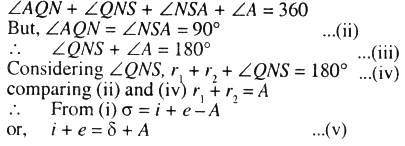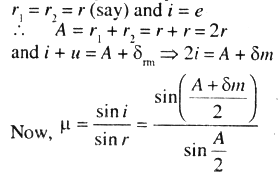
Refraction through a prism
PQ → incident ray, QS → refracted ray
ST → emergent ray
The refracted ray QS is incident on the face AC at an angle r2.The refraction now takes place from glass to air. The ray bends away from the normal on entering air. ST is the emergent ray and 'd' is the angle of emergence.
The ray PQ would have proceeded straight long PQLK in the absence of the prism. But due to refraction by prism. the travels along S.T. Thus, the ray is deviated through and angle σ.This angle is called angle of deviation.
Now LLQS = i - r, ∠CSQ = e - r2.
σ is the.exterior angle of ΔLQS.Since exterior angle of a Δ is equal to sum of interior opposite angles.
σ = i - r, + e - r2 = i + e -(r1 + r2)....(i)
Considering quadrilateral AQNS,

When the prism is placed in the minimum deviation position, then
